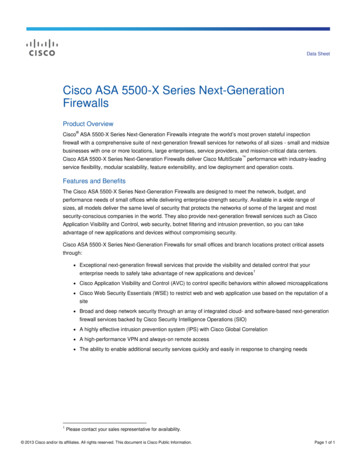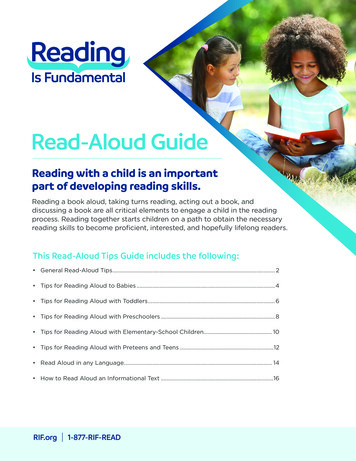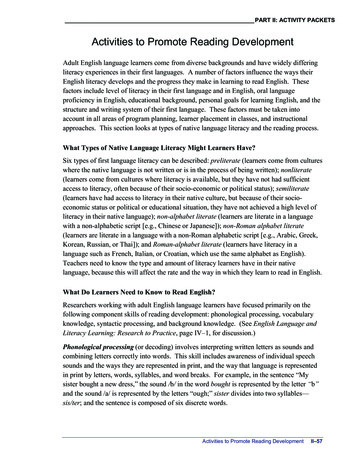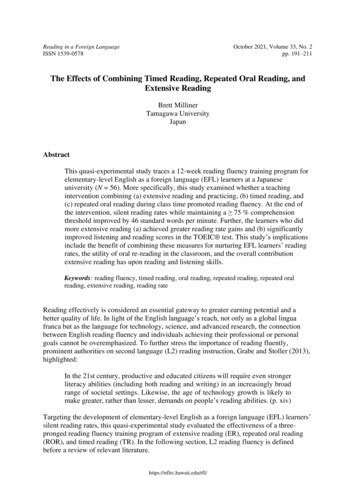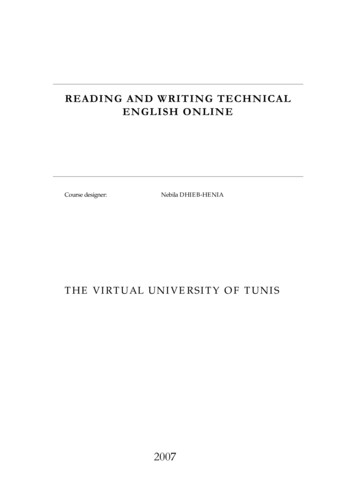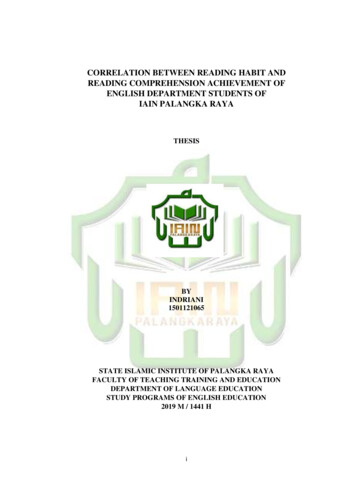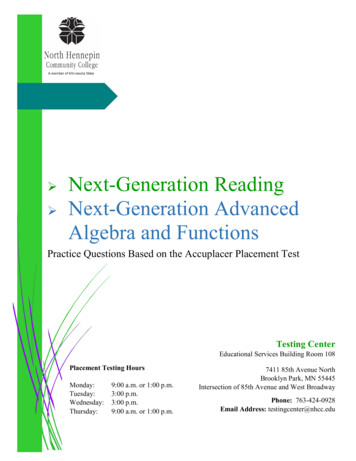
Transcription
Next-Generation ReadingNext-Generation AdvancedAlgebra and FunctionsPractice Questions Based on the Accuplacer Placement TestTesting CenterEducational Services Building Room 108Placement Testing HoursMonday:Tuesday:Wednesday:Thursday:9:00 a.m. or 1:00 p.m.3:00 p.m.3:00 p.m.9:00 a.m. or 1:00 p.m.7411 85th Avenue NorthBrooklyn Park, MN 55445Intersection of 85th Avenue and West BroadwayPhone: 763-424-0928Email Address: testingcenter@nhcc.edu
CONTENTAbout the Placement TestGeneral Test and Review InformationAbout Math Placement TestNext Generation ReadingContent AreaPage 4Sample QuestionsPage 5 - 14Answer Key and RationalizationsPage 15 - 21Math ReviewDevelopmental MathNHCC’s Sample QuestionsPage 22 – 27NHCC Answer KeyPage 27Next Generation Advance Algebra and FunctionsContent AreaPage 28Accuplacer’s Sample QuestionsPage 29 - 24Accuplacer Answer KeyPage 35Accuplacer Problem ReviewPage 35 – 39Calculus ReadinessNHCC’s Sample QuestionsPage 40 – 46NHCC Answer KeyPage 46Page 2Page 3Page 4Page 4 - 11Page 22Page 22 – 27Page 28 – 39Page 40 – 46
About the Placement TestDear Student,Thank you for choosing to pursue your academic, professional, and personal goals here at NorthHennepin Community College (NHCC). This packet contains sample questions intended tohelp the student review for the Next Generation Accuplacer Reading test and math tests inArithmetic, Algebra, and College Level subject areas,The sample questions in this packet are intended to be one of several resources available to aidthe student’s review of mathematical content. Students are encouraged to take advantage ofother resources to aid review, including the websites that are listed within this packet.We wish you success in all your endeavors here at North Hennepin Community College!Best wishes,Testing Center StaffPlacementCourse placement in Math courses will be at either developmental or college-level. Coursesnumbered below 1000 are developmental courses designed to prepare students for success incollege-level courses. Developmental credits do not apply toward a certificate, diploma, ordegree. Courses numbered above 1000 are considered college-level that meet college-levelstandards. College credits apply toward the requirements of a certificate, diploma, or degree.GuidelinesStudents must register for courses according to their placement or for a lower course, but not fora higher course. Students may retest only once a semester for a 10 fee. Otherwise, studentmust complete each course with a “C” or better before moving to the next level.Results for the placement test will be available immediately upon completing the test. TheTesting Advisor will explain test results, course placement, options to retest, and the next steps inthe enrollment process. Online Orientation information Registration Session is completedfollowing the placement test. Course registration will be completed following during aRegistration Session.Placement Test WaiverYou may be eligible for a placement test waiver, which would exempt you from taking one ormore subject on the placement test. To get a copy, you may come in to our office or go towww.nhcc.edu/testing and download a copy of the Placement Test Waiver Request form, whichlists documentation and criteria needed to verify eligibility for a waiver.2
General Test & Review InformationHow to take the placement test Apply to the college – www.nhcc.edu/admissions or in person at the Student Info Desk Schedule an appointment to take the placement test. Call 763-424-0928 to schedule anappointment. Monday 9:00 or 1:00, Tuesday 3:00, Wednesday 3:00. Thursday 9:00 or 1:00. Review! Use this study packet and other recommended resources listed below. Show up! Bring photo identification (passport, state ID, driver’s license) to yourappointment, students cannot test without identification. Arrive 15 minutes early to check-infor testing. The test is not timed. It will take approximately 90 minutes to complete.In addition to this study packet, try these other review resources: Accuplacer Study App – Create an account and log in to take “Next-Generation PracticeTests.” Select “Reading” or “Advanced Algebra and Functions” tests and use “Learn as YouGo” to show the correct answer and receive rationale for the answer to each rg/login. Union Test Prep – Practice Accuplacer tests for Next-Generation Reading, Arithmetic,Algebra and College Math. -test. Test Prep Review - Practice for Next-Generation ccuplacer-reading/. Practice Advanced Algebra and naccuplacer-advanced-algebra-and-function/ Complete Test Preparation – Includes a guide to the Next Generation ReadingComprehension: omprehension-questions/. Practice 1: ion-practice-questions/. Practice 2: ion-practice/. Practice 3: ion-from-fiction/. Math: cer-math/. PCCC – Online practice tests for Reading, Arithmetic, and Algebra. Includes videoexplanations how to solve each question. http://accuprep.pccc.edu/. PracticeTest.com – Practice Reading, Arithmetic, Elementary Algebra, College Level Math.http://www.accuplacerpracticetest.com/ Study Guide Zone – Practice tests for Reading and Arithmetic. Includes skill-buildingexercises focused on content. Additional Math resources ARCC Math Videos – Tutorials for different topics on the Math placement g-services/tutoring-services/msc-video-modules/. Math Help – Review individual content area covered in Accuplacer math tests, with onlinepractice tests and instruction. https://member.mathhelp.com/courses/test prep/151. Ed Ready – Online practice tests to review topics on Accuplacer. https://edready.org/. IXL – Review Algebra 1, Algebra 2, Geometry, and Precalculus topics. https://www.ixl.com/math/. Khan Academy – Access free practice questions and step-by-step video tutorials of mathtopics ranging from early to advanced math. Visit their website http://www.khanacademy.org.3
ACCUPLACER Next-Generation Reading Sample QuestionsThe Next-Generation Reading test is a broad-spectrum computer adaptive assessment of testtakers’ developed ability to derive meaning from a range of prose texts and to determine themeaning of words and phrases in short and extended contexts. Passages on the test cover a rangeof content areas (including literature and literary nonfiction, careers/history/social studies,humanities, and science), writing modes (informative/ explanatory, argument, and narrative), andcomplexities (relatively easy to very challenging). Both single and paired passages are included.The test pool includes both authentic texts (previously published passages excerpted orminimally adapted from their published form) and commissioned texts (written specifically forthe test). Questions are multiple choice in format and appear as both discrete (stand-alone)questions and as parts of sets of questions built around a common passage or passages. Fourbroad knowledge and skill categories are assessed: Information and Ideas (reading closely, determining central ideas and themes,summarizing, understanding relationships)Rhetoric (analyzing word choice rhetorically, analyzing text structure, analyzing point ofview, analyzing purpose, analyzing arguments)Synthesis (analyzing multiple texts)Vocabulary 2017 The College BoardACCUPLACER Next-Generation Reading4
Directions for questions 1-18:Read the passage(s) below and answer the question based on what is stated or implied in thepassage(s) and in any introductory material that may be provided.In this passage, an amateur theater group called the Laurel Players is putting on its firstproduction.(1) The Players, coming out of their various kitchen doors and hesitating for a minute tobutton their coats or pull on their gloves, would see a landscape in which only a few veryold, weathered houses seemed to belong; it made their own homes look as weightless andimpermanent, as foolishly misplaced as a great many bright new toys that had been leftoutdoors overnight and rained on. (2) Their automobiles didn’t look right either—unnecessarily wide and gleaming in the colors of candy and ice cream, seeming to wince ateach splatter of mud, they crawled apologetically down the broken roads that led from alldirections to the deep, level slab of Route Twelve. (3) Once there the cars seemed able torelax in an environment all their own, a long bright valley of colored plastic and plate glassand stainless steel—KING KONE, MOBILGAS, SHOPORAMA, EAT—but eventuallythey had to turn off, one by one, and make their way up the winding country road that led tothe central high school; they had to pull up and stop in the quiet parking lot outside the highschool auditorium.(4) “Hi!” the Players would shyly call to one another.(5) “Hi! . . .” (6) “Hi! . . .” (7) And they’d go reluctantly inside.(8) Clumping their heavy galoshes around the stage, blotting at their noses with Kleenex andfrowning at the unsteady print of their scripts, they would disarm each other at last withpeals of forgiving laughter, and they would agree, over and over, that there was plenty oftime to smooth the thing out. (9) But there wasn’t plenty of time, and they all knew it, and adoubling and redoubling of their rehearsal schedule seemed only to make matters worse.(10) Long after the time had come for what the director called “really getting this thing ofthe ground; really making it happen,” it remained a static, shapeless, inhumanly heavyweight; time and time again they read the promise of failure in each other’s eyes, in theapologetic nods and smiles of their parting and the spastic haste with which they broke fortheir cars and drove home to whatever older, less explicit promises of failure might lie inwait for them there. (11) And now tonight, with twenty-four hours to go, they had somehowmanaged to bring it off. (12) Giddy in the unfamiliar feel of make-up and costumes on thisfirst warm evening of the year, they had forgotten to be afraid: they had let the movement ofthe play come and carry them and break like a wave; and maybe it sounded corny (and whatif it did?) but they had all put their hearts into their work. (13) Could anyone ever ask formore than that?From Richard Yates, Revolutionary Road 1989 by Richard Yates. Originally published in 1961. 2017 The College BoardACCUPLACER Next-Generation Reading5
1. The contrasts the narrator draws in sentences 1 and 2 between the Players’ homes and thehouses in the “landscape” and between the Players’ automobiles and the “roads” are mostlikely meant to suggest that the Players’ homes and automobiles areA.B.C.D.old and neglectedmodern and aliensmall but expensivegrand but unappreciated2. Based on the passage, which of the following most accurately characterizes the claim that“there was plenty of time to smooth the thing out” (sentence 8)?A.B.C.D.A comforting falsehood that the Players know to be untrueAn outright lie that the director persuades the Players to acceptAn optimistic conclusion reached by outside observers watching an early rehearsalA realistic appraisal offered by the director after careful analysis of the play’sshortcomings3. The descriptive language in sentence 10 is mainly intended to reinforce the passage’sdepiction of the Players’A.B.C.D.growing resentment of the director’s leadershipincreasing reluctance to work as hard as they have beenlingering doubts about their fellow cast memberspersistent mood of despair regarding the play4. The narrator most strongly suggests that which of the following resulted in thetransformation described in the last paragraph?A.B.C.D.The change in time of day during which rehearsals were being heldThe greater frequency with which rehearsals were being scheduledThe shift in the director’s style from strict to more forgivingThe break in routine occurring the day before the first performance 2017 The College BoardACCUPLACER Next-Generation Reading6
Passage 1Green Bank, West Virginia, is a tech-savvy teenager’s nightmare. In this tiny town inPocahontas County— population 143—wireless signals are illegal. No cell phones. No WiFi.No radio. No Bluetooth. No electronic transmitters at all. You’re not even allowed to cozy upto an electric blanket.The remote town is smack in the center of the National Radio Quiet Zone, a 13,000 squaremile stretch of land designated by the Federal Communications Commission to protect twogovernment radio telescopes from human-made interference. The rules are most strict inGreen Bank. So strict that a police officer roves the streets listening for forbidden wirelesssignals.It’s necessary, though. The town is home to the Green Bank Telescope, the largest steerableradio telescope in the world—and arguably our most powerful link to the cosmos. Scientiststhere listen to radio energy that has journeyed light years, unlocking secrets about how thestars and galaxies formed. A rogue radio signal could prevent potential discoveries,discoveries that could answer big questions about how the universe ticks.Adapted from Lucas Reilly, “The West Virginia TownWhere Wireless Signals Are Illegal.” 2013 by Mental Floss, Inc.Passage 2Lawn mowers seem to have little in common with astronomy, but they are keepingastronomers at the National Radio Astronomical Observatory up at night. A new type ofrobotic lawn mower has been proposed that uses beacons to train the lawn mower to staywithin property lines. The beacons, placed around the yard, transmit at the same wavelengthas interstellar molecules astronomers study to understand how stars form. Humans wouldn’tnotice the tiny amount of energy given of by the beacons, but the Green Bank Telescope—thesize of a football stadium—is so sensitive it can detect the energy given of by a snowflake asit melts. By simply mowing the lawn, a homeowner runs the risk of interfering with one ofour greatest tools for studying the universe.The manufacturer of one “lawnbot” requested a waiver to operate within the National RadioQuiet Zone. Astronomers countered with the suggestion that the beacons be reprogrammed totransmit at another wavelength not emitted by interstellar molecules. Alternately, astronomerswant global positioning system (GPS) devices added to each lawnbot to prevent them fromoperating within the Quiet Zone. 2017 The College BoardACCUPLACER Next-Generation Reading7
5. The main purpose of the last paragraph of Passage 1 is to Comparison6. Which conclusion can reasonably be drawn about the status of the “lawnbot” issue at thetime of the writing of Passage 2?A. The manufacturer has received a waiver to operate within the National Radio QuietZone.B. The manufacturer has changed the wavelength at which the lawnbot’s beaconstransmit.C. Astronomers have succeeded in getting GPS devices added to each lawnbot.D. The manufacturer and astronomers have yet to resolve their conflict.7. Which choice best describes the relationship between the two passages?A. Passage 1 mainly discusses the National Radio Quiet Zone in general, while Passage 2mainly discusses a particular threat to the zone’s integrity.B. Passage 1 focuses on Green Bank, West Virginia, while Passage 2 focuses on theNational Radio Quiet Zone surrounding the town.C. Passage 1 evaluates drawbacks of the National Radio Quiet Zone, while Passage 2evaluates benefits of the zone.D. Passage 1 offers praise for astronomers, while Passage 2 offers criticism ofastronomers.8. Given the evidence in the passages, with which statement would the authors of bothpassages most likely agree?A. Radio telescopes could be used to measure snowfall amounts.B. The Green Bank Telescope can detect extremely small amounts of energy.C. Increased sales of robotic lawn mowers may require the creation of more radio quietzones.D. The lack of modern technology has made people move away from Pocahontas County. 2017 The College BoardACCUPLACER Next-Generation Reading8
As soon as I saw the Manhattan map, I wanted to draw it. I should be able to draw the placewhere I lived. So I asked Mom for tracing paper and she got it for me and I brought it into myfort and I pointed the light right down on the first map in the Hagstrom Atlas—downtown,where Wall Street was and the stock market worked. The streets were crazy down there; theydidn’t have any kind of streets and avenues; they just had names and they looked like a gameof Pick-Up Sticks. But before I could even worry about the streets, I had to get the land right.Manhattan was actually built on land. Sometimes when they were digging up the streets yousaw it down there—real dirt! And the land had a certain curve to it at the bottom of the island,like a dinosaur head, bumpy on the right and straight on the left, a swooping majestic bottom.From Ned Vizzini, It’s Kind of a Funny Story. 2006 by Ned Vizzini.9. In the passage, the use of “crazy,” “dinosaur head,” “bumpy,” “straight,” and “swooping”serve mainly to emphasize theA.B.C.D.narrator’s serious approach to mapmakingnarrator’s frustration with drawingirregularity of downtown Manhattanways in which a landscape can change over timeThe life of Edith Wharton is not an inspiriting rags- to-riches saga, nor is it a cautionary taleof riches to rags—riches to riches, rather. Born Edith Newbold Jones, in January of 1862, intoone of the leading families of New York, the author maintained multiple establishments andtravelled in the highest style, with a host of servants, augmenting her several inheritances bywriting best-selling fiction. In the Depression year of 1936, when two thousand dollars was agood annual income, her writing earned her a hundred and thirty thousand, much of it fromplays adapted from her works. Yet her well-padded, auspiciously sponsored life was not aneasy one. The aristocratic social set into which she was born expected its women to beornamental, well-sheltered, intellectually idle agents of their interwoven clans, whereas Edithwas an awkward, red-haired bookworm and dreamer, teased by her two older brothers abouther big hands and feet and out of sympathy with her intensely conventional mother, néeLucretia Stevens Rhinelander—a mother-daughter disharmony that rankled in Edith’s fictionto the endAdapted from John Updike, “The Changeling,” a review of thebiography Edith Wharton by Hermione Lee. 2007 by Condé Nast. 2017 The College BoardACCUPLACER Next-Generation Reading9
10. Which choice best describes the overall structure of the passage?A.B.C.D.Biographical incidents are recounted chronologically.An author’s life is connected to various themes in her work.The works of two authors are compared and contrasted.A list of advantages is followed by a list of disadvantages.Bones found in South America reveal a bizarre new dinosaur. Based on an ancestry that linksit to Tyrannosaurus rex, this reptile should have been a meat eater. Instead, it preferred plants.Researchers described the new species in Nature.Its genus name—Chilesaurus—reflects that it was found in what’s now Chile. The team thatdiscovered the fossils gave it a species name of diegosuarezi to honor Diego Suarez. Whilejust 7 years old, Diego found the first dinosaur bones in the same general area of Chile. It’s aplace known as the Toqui Formation.C. diegosuarezi roamed South America 150 million years ago. It measured about 3 meters(roughly 10 feet) from head to tail. Its sturdy back legs, thin body and short, stout arms madeit look a bit like T. rex. But it also had a long neck, small head and a mouth full of leaf-shapedteeth. Those gave it a Brontosaurus-like appearance. And like the Brontosaurus, it wouldhave eaten plants, making it an herbivore.Adapted from Ashley Yeager, “‘Frankenstein’ Dino Showed a Mashup of Traits.” 2015 by Societyfor Science & the Public.11. When the author writes that C. diegosuarezi “should have been a meat eater,” she mostlikely means that the species.A.B.C.D.would have been healthier if it had eaten meatwould have grown even larger if it had eaten meathad the head, neck, and teeth of a meat eaterhad body features similar to those of its meat-eating relative 2017 The College BoardACCUPLACER Next-Generation Reading10
The first album that singer Leehom Wang bought as an adolescent was the Beastie Boys’Licensed to Ill; his first concert was Heart, at the WarMemorial in Rochester, New York. As for Chinese pop music, though, Wang says he recallshearing it only once as a youngster—when his singer uncle, Li Jian-fu, paid a visit in the1980s and played his nationalistic-patriotic hit “Descendants of the Dragon” in Wang’s livingroom.Wang didn’t know it then, but he would go on to remix “Descendants of the Dragon” for anew generation, adding new lyrics about his parents’ own immigrant experience. Over the lastdecade, Wang’s songs have frequently emphasized his dedication to and pride in his Chineseheritage— themes that reflect his personal journey and have a powerful commercial appeal,particularly on the mainland.At the same time, Wang has demonstrated a strong interest in incorporating traditionalChinese music and instruments into his hip-hop and R&B-based tunes.Adapted from Julie Makinen, “Can Leehom Wang Transcend China andAmerica’s Pop Cultures?” 2014 by Los Angeles Times.12. The second paragraph marks a shift in the passage from a discussion of Leehom Wang’sA.B.C.D.family members to Leehom Wang himselfearly musical influences to his later musical careerinterest in the United States to his interest in Chinafondness for pop music to his fondness for traditional musicTechnology has scrambled the lines between public and private. Cellphones make our mostintimate conversations available to anyone within earshot, while headphones create zones ofpure solitude even in the midst of the liveliest crowd. Smartphones and tablets allow us tospend time with art without ever leaving the office, while sophisticated new robots enablepeople who are house-bound to participate in live events remotely.Adapted from Philip Kennicott, “How to Act in Public Spaces in a Digital Age.” 2015 by the Washington Post.13. Which of the following would be most similar to the examples the author provides in thepassage?A. A person’s confidential information is compromised because that person left somepapers in a public place.B. A person enjoys numerous television programs, so that person buys a sophisticatednew television on which to watch them.C. A person’s unfiltered first reaction to a major event becomes widely known becausethat person posts it online.D. A person wants to keep a record of his or her private thoughts, so that person secretlystarts keeping a daily journal 2017 The College BoardACCUPLACER Next-Generation Reading11
Construction management is ideal for someone who has a general interest in building anddesign. Working as a construction manager affords the chance to learn a construction projectfrom the planning stage with architects and engineers, to the budgeting stage with costestimators, to the production stage with laborers. And that’s just a small taste of the job’sduties: Construction managers also obtain work permits, hire contractors, troubleshootemergencies, schedule walkthroughs and keep clients informed on work timetables andprogress.Adapted from “Best Construction Jobs: Construction Manager.” 2015 by U.S. News & World Report LP.14. The passage most strongly emphasizes which aspect of the job of constructionmanagement?A.B.C.D.The variety of its responsibilitiesThe educational background it requiresThe kind of person for whom it is suitableThe amount of stress it inflictsIn this passage, “serialization” refers to the publication of installments, or parts, of anongoing story in a newspaper or magazine.The Pickwick Papers (1836-7) wasn’t the original serialized novel—the format hadexisted for at least a century prior—but it was the work that truly popularized the form.The first installment had a print order of 1,000 copies; by the time the final entry waspublished, circulation had reached 40,000. Buoyed by the success of Pickwick, CharlesDickens serialized his work for the rest of his career, and scores of other notable Victoriannovelists joined the publishing craze. William Makepeace Thackeray’s Vanity Fair,Wilkie Collins’s The Woman in White and Arthur Conan Doyle’s Sherlock Holmes storiesall emerged as serials. Old and new magazines, such as Blackwood’s and HouseholdWords, competed for established and emerging voices. The constant influx of unresolvedplots and elliptical section breaks stoked a fervor for fiction in Victorian England. Itwasn’t until book production became cheap and easy, and new mediums such as radioarose to fill leisure time, that serialization slowly shriveled away.Adapted from Hillary Kelly, “Bring Back the Serialized Novel.” 2015 by the Washington Post15. Which of the following does the author offer as evidence to support the point that, for atime, serialization was highly successful?A.B.C.D.The change in circulation for The Pickwick PapersThe use of unresolved plots and elliptical section breaksThe decrease in cost of book productionThe development of new mediums, such as radio 2017 The College BoardACCUPLACER Next-Generation Reading12
The neighborhood of Harlem in the twenties offered up a cultural richness that madeeverything seem possible. Jervis Anderson, writing in the New Yorker in 1981, noted,“Harlem has never been more high-spirited and engaging than it was during the nineteentwenties. Blacks from all over America and the Caribbean were pouring in, reviving themigration that had abated toward the end of the war—word having reached them about the‘city,’ in the heart of Manhattan, that blacks were making their own.”Adapted from Hilton Als, “The Sojourner.” 2015 by Condé Nast.16. Based on the passage, Anderson puts “city” in quotation marks most likely toA.B.C.D.introduce irony into his writingsignal a nonliteral usagemark a citation of another authorindicate the inclusion of dialogueCertainly, scholars are driven toward a “regression to the safe,” as science historian AliceDreger puts it, though that is not, as she implies, particularly new in the Internet age. SinceGalileo’s time, thinkers have relied on the patronage of others to fund their work, and thatpatronage—be it from government, business interests or individuals— generally extracts aprice. In Galileo’s case, that meant softening his position on the Copernican theory underpressure from the pope. In the case of science today, despite Dreger’s argument, that pressurecomes less as a consequence of political correctness than of economic forces that have shiftedacademic and scientific institutions to a corporate model not designed to prioritize publicinterests. In the academy, it is money far more than ideology that rules the day.Adapted from Ellen Ruppel Shell, “In Science, Has Evidence Given Way to Ideology?” 2015 by the Washington Post.17. It can reasonably be concluded from the passage that in the author’s opinion, scientificresearch today is chiefly impaired by theA.B.C.D.influence of the academic institutions with which scientists are affiliatedoverabundance of information available to scientists in the Internet agepressure on scientists to make their outcomes socially acceptableoperation of economic forces potentially hostile to the common good 2017 The College BoardACCUPLACER Next-Generation Reading13
Sherry Turkle of the Massachusetts Institute of Technology has been writing abouthuman- technology interactions for the past three decades. She has become increasinglywary of the capacity of online spaces to fulfill us in the ways we seem to want them to.According to Turkle, part of the problem with the internet is that it encourages selfinvention. “At the screen,” she writes in Alone Together (2011), “you have a chance towrite yourself into the person you want to be and to imagine others as you wish them tobe, constructing them for your purposes. It’s a seductive but dangerous habit of mind.”Adapted from Olivia Laing, “The Future of Loneliness.” 2015 by Guardian News and Media Limited .18. The main purpose of the passage is toA.B.C.D.evaluate conflicting assessmentspresent a sharp critiquepropose a necessary remedyprovide background detailsDirections for questions 19-20The following sentence has a blank indicating that something has been left out. Beneath thesentence are four words or phrases. Choose the word or phrase that, when inserted in thesentence, best fits the meaning of the sentence as a whole.19. Deciding that none of the nominees was the award, the film committeebegan reviewing a new group of candidates with better qualifications.A.B.C.D.known forpleased withworthy ofinterested in20. Nuclear engineer Meena Mutyala argues that nuclear power is an environmentally technology, operating with essentially no emissions.A.B.C.D.lavishculpableantagonisticbenign 2017 The College BoardACCUPLACER Next-Generation Reading14
Reading Comprehension Answer C20DRationales1. Choice B is the best answer. Sentence 1 notes that in the “landscape,” “only a few veryold, weathered houses seemed to belong”; by contrast, the Players’ houses seemed“weightless,” “impermanent,” and “misplaced,” like “bright new toys.” Sentence 2establishes that the Players’ automobiles “didn’t look right either,” that they appeared“unnecessarily wide an
In addition to this study packet, try these other review resources: Accuplacer Study App – Create an account and log in to take “Next-Generation Practice Tests.” Select “Reading” or “Advanced Algebra and Functions” tests and use “Learn as You Go” to show the correct answ



